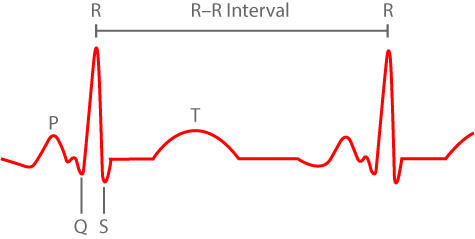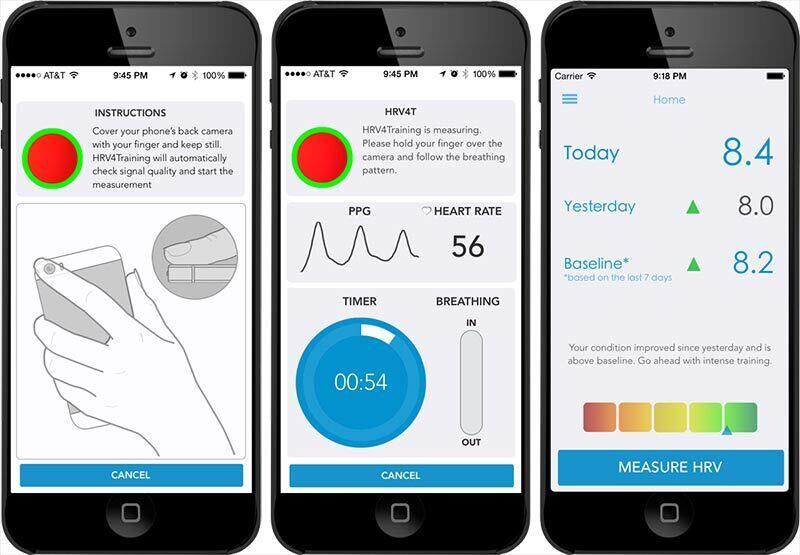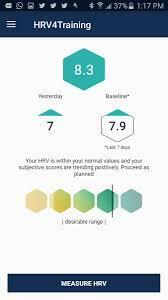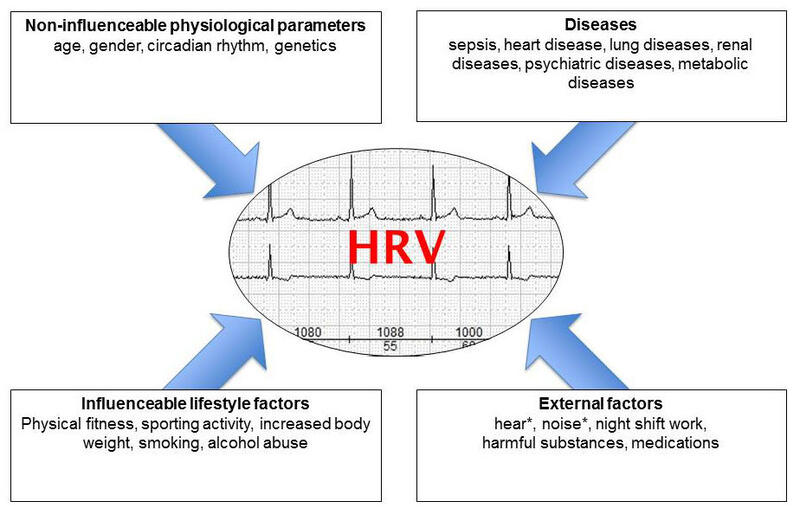![]()
When it comes to health and fitness tracking, one of my favorite health data points is Heart Rate Variability.
Abbreviated as “HRV, “Many doctors and athletes consider heart rate variability to be one of the best biomarkers for understanding how your body, health, and fitness are affected by a whole host of factors like training load, sickness, alcohol, nutrition, sleep, and air quality to name a few. Psychologists have even used HRV through activities like meditation and guided breathing to treat psychological issues. While it’s mostly been used by elite and Olympic athletes to gauge their training stimulus, load and recovery, it’s increasingly become a useful data point for the recreational athlete too.
In short, Heart Rate Variability (HRV) is a great biomarker to understand your life.
What can HRV data be used for? HRV can be used to help you look at how certain lifestyle changes affect you. For example, by measuring HRV, you can see correlations in how a previous day of hard training, a night of poor sleep or excessive drinking among a few notable factors affects your HRV value the next day. Over longer periods you can use HRV readings to see other chronic trends in your health, wellness and fitness.
For self-tracker and quantified self enthusiasts, HRV data provides a reference point for understanding aspects of your life and your self-experiments. The challenge is that you can’t run a controlled experiment when your sample size is only you. Fortunately, with HRV it becomes possible to measure the effect of life changes in terms of your HRV. For example, HRV data can be a good data point to measure the effect of different training or nutrition regimes.
One of the other great features of Heart Rate Variability is that it is a particularly easy biomarker to measure. Using either your phone or a chest strap heart rate monitor, there are several services that can enable you to log your reading to your smart phone and then help you track changes over time. In about a minute, you can log your HRV biomarker. There are also several running watches and wearables that provide an estimation of your HRV too.
As a slightly obsessive self-tracker, I measure many aspects of my life, including my productivity time, my workouts, my tasks, my weight and many others. Personally, I measure my HRV each morning and have seen connections and correlations between several aspects of life and my HRV scores. For example, during my recent marathon training and 42k run, I saw noticeable changes in my HRV readings, and, as a regular traveler, it is easy to spot how long and short travel affects us physiologically.
So, what is HRV? What are you measuring with HRV? What does this particular measurement signal when it comes to your health and fitness? What are a some things that affect your HRV and how can you see this in your data? And finally why should HRV matter in general and for you personally?
In this long post, we are going to explain what is HRV and how it is measured (both practically as a user and scientifically as a biomarker). We will look at why it is important to log the context with your HRV and some of the factors that can affect your HRV day to day and chronically over time.
This post is intended as a beginner’s intro to HRV, so we’ve left out the deeper science behind HRV, including the automatic nervous system. I plan to provide more on this and demographic HRV comparisons in a later post.
Obviously the body and its interaction are complicated. Yet HRV remains an incredibly interesting data point to better understanding yourself. Let’s dig in!
Heart Rate Variability: What Are You Measuring?
Our heart rate does not beat at a constant rate. So even though your heart rate might be 60 beats per minute, that doesn’t mean it beats exactly once every second. The reality is that your heart rate differs slightly over time so it might be 0.9 seconds one beat or 1.1 seconds on another.
When it comes to HRV we are looking at this variation between beats. HRV is a way to quantify that variation or variability between heart beats.
Heart Rate Variability (HRV) measures how your heart rate varies over time. The two main parts to measuring your HRV are R-R intervals and RMSSD (Root Mean Square of the Successive Differences). Let me explain what these two terms mean.
If you can visualize the classic EKG or ECF spiked line you see for tracking your heart, R-R intervals are measuring the time between those spikes. R stands for the peak of heart beat and thus these are called R spikes. With Heart Rate Variability, you are measuring the variation of these spikes.

Like a lot of measurements like distance, weight or others, we eventually need a standard to compare and understand any measurement. RMSSD is that standard for HRV.
Once you have measured R-R Intervals and your heart rate (typically over a minute), the practice is to then calculate the differences using RMSSD, which stands for Root Mean Square of the Successive Differences. It is an equation to determine how much variance your heart rate and nervous system are showing. Specifically, are your heart rate beat intervals more consistent (showing low variability) or more flexible (show higher variability)?
By the measuring the intervals between a series of heart beats and calculating that variance, you get your Heart Rate Variability or HRV.
Practical Speaking: How to Measure Your HRV?

Now that we know what HRV is and how scientifically it is measured, let’s look at how you can measure your own HRV.
Previously HRV was measured using $20,000 machines. Fortunately this has changed and you can measure your HRV with a $50 HR strap or even using your phone.
Currently there a few approaches to measuring your HRV. The most common method is using a chest strap heart rate monitor and a mobile app. During a one or two minute period, the chest strap heart rate monitor records your heart rate and R-R intervals and is transmitted to an app where following the test your HRV is calculated.
To understand how this works it is good to recall that our body is also an electrical system. During heart beats, an electrical signal is sent by our body through the heart muscle telling it to contract. Chest strap heart rate monitors pick up and measure this electrical activity through the skin. Using a transmitter this data is sent to a watch or phone. It can also be stored locally on the wearable too.
The most recommended chest strap heart rate monitors include models from Polar and Wahoo. Suunto also has a popular model too. These devices are most commonly used to measure your active heart rate during workouts. I personally use Wahoo’s Tickr X.
There are several apps for both Apple and Android for HRV. Essentially these apps pull the real-time heart rate data to measure your R-R Interval and then to calculate your RMSSD or HRV. I’ve personally used EliteHRV but there are several others that come highly reviewed in the App Stores, like Bioforce.

One alternative to using a chest strap is to use your phone’s camera to capture your heart rate. HRV4Training provides an application on iPhone and recently added an Android version.
Using the phone camera and light emitting diode, HRV4Training app employs a technique called photoplethysmography (PPG for short), where it essentially detects changes in blood volume during a cardiac cycle. These changes are then used to determine your heart rate beat and, in turn, used to calculate your HRV.
While there is some debate about the accuracy of measuring HRV and heart rate via your phone’s camera, the developers of HRV4Training have provided an in-depth analysis in the post, “Heart rate variability using the phone’s camera”.
I’ve done some comparisons with information I was getting using EliteHRV (with a Wahoo Heart Rate Monitor) and HRV4Training (with iPhone 6) and I found the readings quite similar.
While accuracy might be improved using a chest strap, heart rate monitor, personally the added effort to measure via this method meant I was less diligent in my daily measurements.
By contrast, HRV4Training takes only a minute and I can capture my HRV upon waking. As such I’ve got an almost daily reading of my HRV and other data points since I started using HRV4Training a few months ago. HRV4Training app also provides a lot of interesting charts and comparisons too.
There are a few wearables and smart watches that attempt to track HRV. Fitbit and Garmin devices attempt to measure HRV as does a lesser known product called ZoomHRV from LifeTrack. Apple Watch is not recommended for HRV. Overall the jury is still out if you can reliably capture HRV from wrist devices. That said, if you are looking to just have a general HRV number, then this method should work. In the future, I expect to see wearables that can do continuous HRV readings.
Let’s turn to other points to remember when tracking your HRV, before looking into what affects your HRV.
Be Consistent: When Should I Measure My HRV?
![]()
The most important thing when it comes to measuring anything is to be consistent. Whether it is your weight or your body temperature, you should aim to measure this under the same conditions everyday. Similarly, you should measure your HRV at the same time every day and under the same conditions, if possible.
While you can measure your HRV anytime you like, if you are looking at trends and comparisons, you should attempt to measure it once a day under similar conditions. Typically this is done in the morning.
For me this means measuring my HRV when I wake up, before I eat or have my morning coffee. Similarly you should take your reading in the same bodily position, like sitting up, laying down, etc. Any of these changes will affect your HRV score.
According to a few sources, you can get a good trending line on your HRV if you measure it at least 4 times per week. Obviously you should try to record this daily, but having 4-5 measurements per week should be enough, so don’t fret if you miss it once or twice.
Context Matters with HRV, So Capture It.
Context is important when you attempt to understand your HRV. Your HRV varies according to a host of factors. High or low HRV can be be good or bad depending on the context. In order better understand the meaning behind your HRV score you should also log a few contextual data points.
Apps like EliteHRV and HRV4Training let you log additional factors along with the HRV reading. You can note your sleep, alcohol consumption, traveling and training from the day before. This contextualization helps in understanding your HRV score.
You should try to capture at least how much sleep you got the night before, how much training you did, did you travel, and did you drink. These points in particular have a reliable correlation to HRV changes. Fortunately, once you’ve measured HRV for awhile, you should see some specific connections these events and your HRV.
For more on how to measure your HRV, checkout HRV4Training’s Getting Started Guide or EliteHRV’s Tutorial. Similarly checkout “The 8 Biggest Mistakes Made When Measuring Heart Rate Variability” from more on best practices.
The key point is gaining a consistent HRV reading every morning over time.
Getting Actionable with HRV: HRV Baseline and Recovery Points

While one-off measurements of HRV can be useful, the most valuable aspect of HRV comes from changes over time, meaning over a few days, weeks or even months. These trends reveal how certain factors are affecting your wellbeing and health like sleep, training, air, alcohol, among others. This shows chronic trends.
Depending on your app or HRV service, you won’t be able to know much about your HRV until you’ve set your baseline HRV. For most that means at least 4 or 5 days of measurements are required, and in general your baseline HRV is determined from the last week. Most HRV apps and services provide a 7-Day Trailing Average HRV, which is the average of your HRV values over time.
Seeing variation in your RMSSD from 41.3 to 55.3 or whatever can appear highly technical. Our minds crave simplicity. So, while it’s good to record these numbers, HRV services typically take your measurements and HRV readings and present them in an easy to understand format.
Using a 10-point scale, HRV4Training and EliteHRV give you a score like 7.1, 8.3, etc. HRV4Training calls this your recovery points and EliteHRV calls it your morning readiness. The idea is to have a simple number, so it can better guide your actions.
Once your have a HRV baseline (whether as normalized rMSSD or recovery score), apps like HRV4Training or EliteHRV can provide daily insights or advice based on an objective measurement (RMSSD) and your subjective logs (how you feel, how you sleep, etc.).
Typical advice on a day where your subjective and objective score are trending negatively would be to take the day off, recover or a workout of active rest. On a day where your subjective and objective score are positive then the advice would be to proceed with training as planned or even push it a bit harder. Where the subjective and objective scores conflict, the advice is to consider taking it easier but proceed as planned. The goal is to stay within the desirable range so you can training (and live) reasonability.
While HRV numbers can seem highly technical and confusing, the goal of HRV as a biomarker and training tool is simple: it should help you by providing an objective data point and recent trends, so you can understand how to make better decisions about your training and behaviors.
While differences in populations, age groups and demographics do exist with HRV scores and this is a topic for more advanced understanding of HRV, what matters for employing HRV in your life is taking it as a personal data and understanding how specific factors in your life can affect it over time.
Correlations and Insights: What Affects My HRV?
A single HRV reading combined with your average can provide a daily takeaway on how you might tweak your training. Looking more broadly at the data, your HRV data can also be interpreted in the context of various physiological stressors, like training load, stress, recovery, travel, alcohol and others.
It’s impossible to draw an actual causality link between your HRV and specific factors, but by looking at lots of consistent data over time, you can start to see correlations and gain valuable insights. Additionally since HRV is proxy into your automatic nervous system (fight-or-flight mode), this provides a broader context in order to understand how your physiological nervous state might trend according to your HRV.
Acute stressors can be understood as events that affects you physiologically. Think about an intense aerobic workout, a daylong drive, an international flight, a long night of too much drinking, work or relationship drama or other things that cause physical and physiological stress. These events tend to have a pretty immediate effect upon our immediate future. So, for example, yesterday’s acute stressor will show up in our HRV score today.
Furthermore on-going, long-term or “chronic” factors will show up over time. So a stressful job situation and family problems among others will affect your HRV too. These changes won’t necessarily show up in daily changes but can be noticed when you compare different periods or your overall trend. Doctors, for example, can use these HRV trends and discover less noticeable positive or negative changes.
The body is an complex system. So it is difficult to completely reduce what’s going on in your body with any single factor. Fortunately, while research remains to fill the gaps, a lot of good research has been done to understand the key factors that influence HRV.
In “Factors influencing heart rate variability” in Volume 6 (2016) of International Cardiovascular Forum Journal, Stefan Sammito and Irina Böckelmann group them into four main areas: Non-influencial physiological parameters, diseases, influenceable life style factors and external factors:

Several factors have an affect on your HRV score (like disease and medications) and I highly recommend the cited article if you wish to look at this in detail. Since our focus is on HRV for individual usage, let’s look at some of the lifestyle factors that we can control and which influence our HRV. These factors can have both a positive and negative influence on HRV. (All citations are from this paper.)
- Overtraining: “Cumulative or too intensive sporting activity (e.g. competition series, overtraining syndrome), however, brings about a decrease in HRV”
- Physical Fitness: “People who have an active lifestyle and maintain a good or high level of physical fitness or above-average sporting activity can achieve an increase in their basic parasympathetic activity and thus an increase in their HRV.”
- Overweight: “an elevated body weight or elevated free-fat mass57 correlates with a decrease in HRV. Both active and passive smoking lead to an increase in HRV”
- Alcohol Abuse: “Regular chronic alcohol abuse above the alcohol quantity of a standard drink for women or two standard drinks for men reduces HRV, while moderate alcohol consumption up to these quantities does not change the HRV and is not associated with an increase”
- Smoking: “Both active and passive smoking lead to an increase in HRV”
- Sleep: Another important factor that affects your HRV score is the amount and quality of your sleep.
The authors put climate and job-related parameters into external factors, though in someways they are also influenceable by life choices. Here is the gist: “Climatic factors lead to changes in HRV due to the physiological reaction of the vegetative nervous system. Heat increases sympathetic nervous system activity, reducing HRV60,61. Long-term exposure to cold (e.g. at work or during the winter months) has not been found to have an influence on HRV due to adaptation effects, e.g. after 60 days. Exposure to noise likewise leads to a decrease in HRV because it increases sympathetic nervous system activity. Induced pain also results in a lowering of HRV due to the activation of the physiological sympathetic nervous system.”
Overall, the key takeaway here is that research has found connections between HRV scores and training (and overtraining), physical fitness level, smoking, drinking, obesity and a host of other factors. This means your measurement can enable you to know yourself and treat small bodily changes before they become chronic problems.
Conclusion: HRV: A Biomarker to Help See What Affects You
To borrow a great definition, “Heart rate variability (HRV) is the physiological phenomenon of variation in the time interval between heartbeats. It is measured by the variation in the beat-to-beat interval.”
In this post we went deep into a number aspects of HRV and the biological and nervous systems this reading is a proxy into understanding. By consistently measuring your HRV and collecting related data points on your workouts and lifestyle (sleep, drinking, travel, etc.), you start to gain a wealth of data that can be analyzed to see various patterns.
Personally, HRV is one of my most useful health and fitness data points. Along with tracking my sleep, active heart rate and workouts, tracking my HRV everyday gives me a clear view on my training quality and overall wellbeing. There are several high quality tools that let everyday people measure this data point using a chest heart rate monitor or even a smart phone. Considering it only takes about 1 minute each morning to track, it isn’t a huge a time suck either.
You can learn a lot from your HRV. On a day-to-day level you can see correlations between factors and how they affect your HRV. Drank too much last night, you’ll see it in your HRV. A hard day of training, poor sleep or too much travel, you might see this in your HRV too. HRV can help you know when to push harder and when to take a bit more rest and self-care.
On a longer trending scale you can see how your health and fitness are improving (or inversely deteriorating). Figuring out the exact “cause” is hard due to the complex nature of the human systems and the factor influencing our lives and health.
Fortunately, a whole host of factors have been researched and shown to influence your HRV. While some things like age, gender and diseases might be outside your control, a lot of what affects your HRV (and your health in general) are lifestyle choices. These are things you do control and you can use HRV to understand it.
By consistently tracking your HRV and engaging in different modifications of your lifestyle through nutrition, workouts and life changes, you will see different changes. HRV helps you understand it and know when a change is a good one (or not). We can craft lives where we feel more energy, perform better, faster, and stronger and live longer, healthier lives. HRV is a great data point into this.
Tell me how your HRV tracking goes. Good luck and happy tracking!
